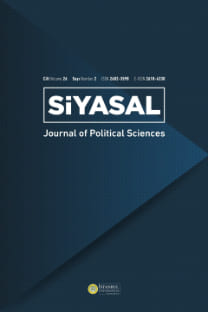SPATIALLY SEGREGATED AND SOCIALLY EXCLUDED TURKISH MIGRANTS IN NORTHERN CYPRUS: AN ALTERNATIVE PERSPECTIVE
This study attempts to analyse the migration flows from Turkey to Northern Cyprus since 1974 which are historically different in nature and have different significances in different periods. Out of the three migration waves that can be identified since 1974, the first and the third waves are the subjects of this study. The analysis includes integration/segregation processes of Turkish migrants in Northern Cypriot society and their position in the re-construction of economic, social and spatial division of labour which had started to disintegrate in 1963 and collapsed in 1974 after the division of the Island as two separate political geographies. This study argues that migrants were the main pillars of the re-construction of division of labour process in the Northern part of the Island and it tries to elaborate a migrant-biased perspective instead of looking through the strong strategic and political presumptions, which can easily conceal the social reality of being a migrant and their reality as a class in the society.
Anahtar Kelimeler:
İşgücü Göçü, Kuzey Kıbrıs, Sosyal Dışlanma, Mekansal Ayrışma, Nüfus Mühendisliği
This study attempts to analyse the migration flows from Turkey to Northern Cyprus since 1974 which are historically different in nature and have different significances in different periods. Out of the three migration waves that can be identified since 1974, the first and the third waves are the subjects of this study. The analysis includes integration/segregation processes of Turkish migrants in Northern Cypriot society and their position in the re-construction of economic, social and spatial division of labour which had started to disintegrate in 1963 and collapsed in 1974 after the division of the Island as two separate political geographies. This study argues that migrants were the main pillars of the re-construction of division of labour process in the Northern part of the Island and it tries to elaborate a migrant-biased perspective instead of looking through the strong strategic and political presumptions, which can easily conceal the social reality of being a migrant and their reality as a class in the society.
Keywords:
Labour Migration, Northern Cyprus, Social Exclusion, Spatial Segregation, Population Engineering.,
___
• AKGÜN, Mensur., GÜREL, Ayla., HATAY, Mete., and TİRYAKİ, Sylvia. 2005. Quo Vadis Cyprus?, TESEV Working Paper.• AN, Ahmet. 2006. Kıbrıs Türk Toplumunun Geri Kalmışlığı (1892-1962). Kyrenia: Şadi Kültür ve Sanat Yayınları I.
• BYRNE, David S. 2005. Social Exclusion, Maidenhead/UK: Open University Press.
• GOUGH, Jamie., EISENSCHITZ, Aram and MCCULLOCH, Andrew. 2006. Spaces of Social Exclusion. London and New York: Routledge.
• GÜREL, Ayla, and ÖZERSAY, Kudret. 2006. The Politics of Property in Cyprus. Conflicting Appeals to “Bizonality” and Human Rights by the Two Cypriot Communities. Oslo: International Peace Research Institute (PRIO) Paper 3.
• HATAY, Mete. 2005. Beyond Numbers: An Inquiry into the Political Integration of the Turkish “Settlers” in Northern Cyprus. Oslo/Nicosia: International Peace Research Institute (PRIO) Report 4.
• HOCKNELL, Peter., CALOTYCHOS, Vangelis and PAPADAKIS, Yiannis. Eds.1998. “Introduction: Divisive Cities, Divided Cities: Nicosia”, Journal of Mediterranean Studies. 8(2): 147-168.
• İNANÇ, Gül. 2007. Büyükelçiler Anlatıyor: Türk Diplomasisinde Kıbrıs (19701991). Istanbul: Türkiye İş Bankası Kültür Yayınları.
• KOOPMANS, Ruud., STATHAM, Paul., GIUGNI, Marco and PASSY, Florence. 200 Contested Citizenship, Immigration and Cultural Diversity in Europe. Minnesota: University of Minnesota Press. • KURTULUŞ, Hatice. 2007. “Global Flows and New Segregation in Istanbul: How Cloudy Class Identities Have Crystallized in Urban Space.” In Globalizing Cities: Inequality and Segregation in Developing Countries, edited by Ranvinder Singh Sandhu and Jasmeet. Sandhu, 309-338 . New Delhi: Rawat Books.
• KURTULUŞ, Hatice, and PURKIS, Semra. 2008. “Türkiye’den Kuzey Kıbrıs’a Göç Dalgaları: Lefkoşa’nın Dışlanmış Göçmen-Enformel Emekçileri.” Toplum ve Bilim 112: 60-101.
• KURTULUŞ, Hatice, and PURKIS, Semra. 2009. Kuzey Kıbrıs’a Türk Göçünün Niteliği ve Göçmenlerin Ekonomik Sosyo-Mekansal Bütünleşme Sorunları, TÜBİTAK Project No: 106K330.
• PURKIS, Semra. 2008. “Türkiye’den Kuzey Kıbrıs’a Son Göçlerde Kadın İşgücünün Göçmenlik Halleri.” Eğitim Bilim Toplum, 6(23): 6-35.
• SASSEN, Saskia. 2006. “The Repositioning of Citizenship and Alienage: Emergent Subjects and Spaces for Politics”, In Displacement, Asylum, Migration, edited by Kate E. Tunstall, 176-203. UK: Oxford University Press.
• SCHIREUP, C., Ulrich. 2007. “Social Exclusion, Diversity, and the EUs Anti-Discrimination Agenda”, In European Anti-Discrimination and the Politics of Citizenship, edited by Christophe Bertossi, 99-124. US, UK: Palgrave Mcmillan.
• TRIMIKLINIOTIS Nicos. 2004. “Mapping Discriminatory Landscape in Cyprus: Ethnic Discrimination in a Divided Education System.” Cyprus Review 15(2): 53-86. • __________ 2007. Report on Measures to Combat Discrimination, Cyprus Country Report.
• ___________ 2007a. “Racism, Migrants as Social Actors and the Transformations of Cypriot Society: in Search of a New Cypriot Consciousness.” Immigrants in Cyprus “New Cypriots” or Discriminated Outsiders, Paper presented for the German Cypriot-Forum (DZF) and the Cyprus Academic Forum (CAF) conference on the occasion of Germany’s EU Presidency.
• TRNC, SPO (State Planning Organisation). 2009. “Household Labour Force Statistics 2004-2006”, Accessed May 01. http://www.devplan.org/ Frame-tr.html.
• ZETTER, Roger. 1992. “Refugees and Forced Migrants as Development Resources: The Greek Cypriot Refugees from 1974”, Cyprus Review 4 (1): 7-39.
• ________ 1994. “The Greek-Cypriot Refugees: Perceptions of Return under the Condition of Protracted Exile”, International Migration Review 28(2): 307-322.
- ISSN: 1303-1260
- Yayın Aralığı: Yılda 2 Sayı
- Yayıncı: İstanbul Üniversitesi
Sayıdaki Diğer Makaleler
ULUSLARARASI İLİŞKİLER BAĞLAMINDA ORTADOĞU'DA BÜYÜK
ALTIN, DÖVİZ VE HİSSE SENEDİ PİYASALARINDA OYNAKLIK ETKİLEŞİMİ MEKANİZMASININ ANALİZİ
İKTİSAT VE DENEYSEL YÖNTEM: DENEYLER, TARTIŞMALAR VE GELECEK
TÜRKİYE'DE KAMU KESİMİ AÇIKLARININ NEDENLERİ VE FİYATLAR GENEL DÜZEYİ ÜZERİNDEKİ ETKİLERİ
